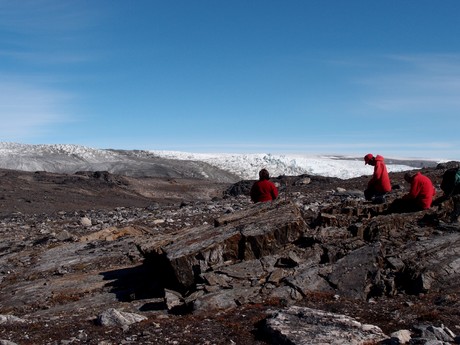3.7-billion-year-old fossils discovered

Australian researchers have uncovered the world’s oldest fossils in a remote area of Greenland. Their study, published in the journal Nature, pushes back the fossil record to near the start of the Earth’s geological record and points to evidence of life on Earth very early in its history.
The team discovered 3.7-billion-year-old stromatolite fossils — mounds of carbonate constructed by communities of microbes — in the world’s oldest sedimentary rocks, in the Isua Greenstone Belt along the edge of Greenland’s icecap. The 1–4 cm fossils were exposed by the recent melting of a perennial snow patch and were laid down in shallow sea, providing the first evidence of an environment in which early life thrived.
“The significance of stromatolites is that not only do they provide obvious evidence of ancient life that is visible with the naked eye, but that they are complex ecosystems,” said study leader Professor Allen Nutman, from the University of Wollongong, who added that the fossils predate the world’s previous oldest stromatolite fossils — which were found in Western Australia — by 220 million years.
“This indicates that as long as 3.7 billion years ago, microbial life was already diverse,” he said. “This diversity shows that life emerged within the first few hundred millions years of Earth’s existence, which is in keeping with biologists’ calculations showing the great antiquity of life’s genetic code.”

Co-lead investigator Associate Professor Vickie Bennett, from the Australian National University (ANU), said the team’s discovery “turns the study of planetary habitability on its head”.
“Rather than speculating about potential early environments, for the first time we have rocks that we know record the conditions and environments that sustained early life,” she said. “Our research will provide new insights into chemical cycles and rock-water-microbe interactions on a young planet.”
Professor Martin Van Kranendonk, from the University of New South Wales, added that the find could point to similar life structures on Mars, which 3.7 billion years ago was a damp environment.
“The structures and geochemistry from newly exposed outcrops in Greenland display all of the features used in younger rocks to argue for a biological origin,” Professor Van Kranendonk said.
“This discovery represents a new benchmark for the oldest preserved evidence of life on Earth. It points to a rapid emergence of life on Earth and supports the search for life in similarly ancient rocks on Mars.”
Rapid sensor can detect pregnancy complications sooner
Researchers have developed a rapid sensor that can detect pregnancy complications as early as 11...
New test could optimise preventive treatment for heart attacks
A simple scoring system could revolutionise how doctors prevent heart attacks and strokes by...
Selective combustion removes pollutants from industrial processes
Researchers have discovered how a catalyst can be used to selectively burn one molecule in a...




